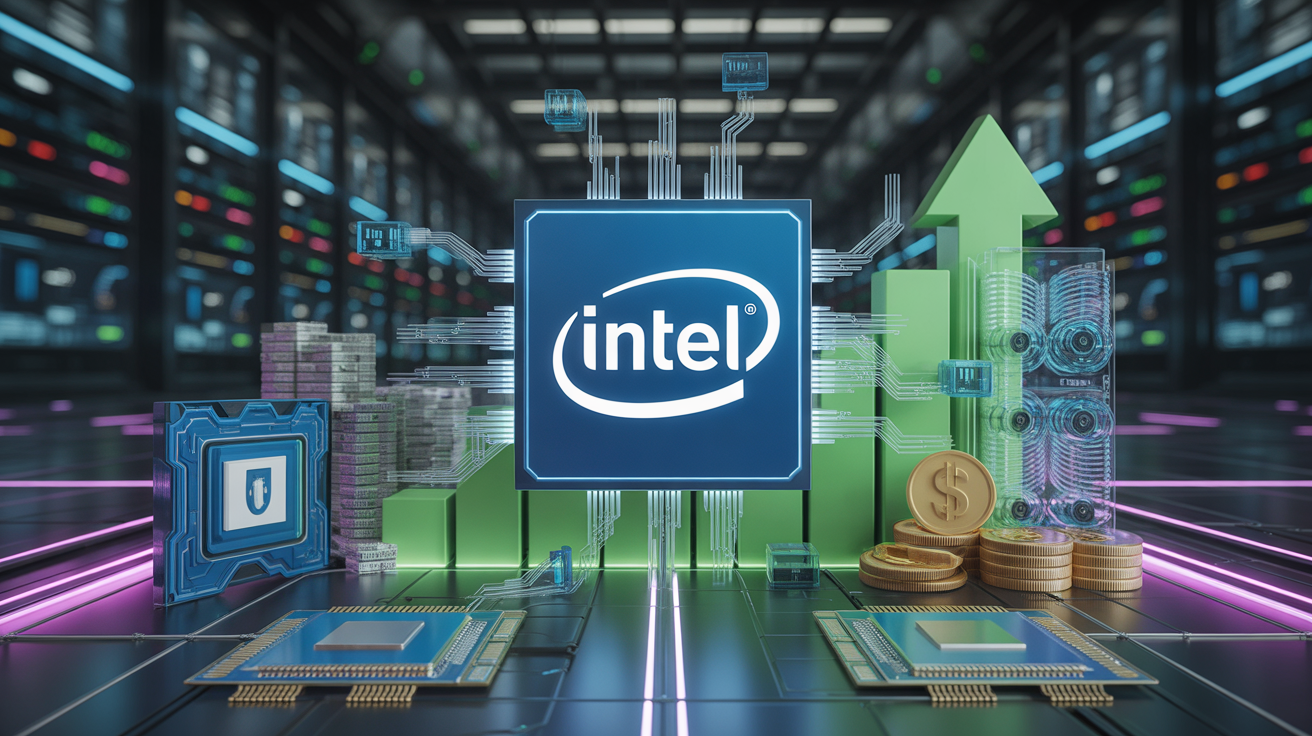
Intel Corporation has surpassed market expectations with its latest financial results, driven by solid profits and strategic investments in technology and infrastructure. This performance signals a potential recovery in the semiconductor and broader tech sector, reaffirming Intel’s position as a key player in global technology markets.
Investors, analysts, and industry observers are closely examining Intel’s results, as they provide insights into technology sector trends, investment opportunities, and corporate strategy execution.
📊 Intel’s Financial Performance
In its latest earnings report, Intel highlighted:
- Revenue Growth: Revenue exceeded analyst forecasts, supported by strong demand in data centers, cloud computing, and AI applications.
- Profit Margins: Solid margins reflect operational efficiency and product mix optimization, reinforcing investor confidence.
- Earnings Per Share (EPS): EPS surpassed consensus estimates, reflecting effective cost management and revenue expansion.
- Investment Initiatives: Intel is committing significant capital to chip fabrication, R&D, and next-generation semiconductor technologies, positioning itself for long-term growth.
These results not only demonstrate short-term financial strength but also signal Intel’s strategic readiness to capitalize on emerging technology trends.
🌐 Strategic Investments Driving Growth
Intel’s investments focus on several key areas:
- Advanced Semiconductor Manufacturing:
Building state-of-the-art fabrication facilities to compete in high-performance and AI chip markets. - Artificial Intelligence (AI) and Data Centers:
Expanding solutions for AI workloads, cloud computing, and enterprise infrastructure. - Research & Development (R&D):
Innovating next-generation chips and technologies to maintain market leadership and competitive advantage. - Global Supply Chain Expansion:
Investments in global logistics and partnerships ensure resilient operations amid geopolitical and market uncertainties.
These strategic initiatives underscore Intel’s long-term vision and commitment to maintaining its technological edge.
💡 Market Implications
Intel’s strong results and investments have broader implications for the technology and investment landscape:
- Tech Sector Recovery: Positive earnings indicate that semiconductor demand remains robust, supporting optimism in related tech stocks.
- Investor Confidence: Beating expectations restores faith among institutional and retail investors, potentially attracting further capital inflows.
- Global Supply Dynamics: Intel’s investments in manufacturing may reduce chip shortages, benefiting industries reliant on semiconductors, from automotive to consumer electronics.
- Innovation Leadership: Intel’s commitment to AI, cloud computing, and high-performance chips positions the company to lead future technology trends.
📊 Stock Market Reaction
Intel’s share price responded positively to the earnings announcement:
- Immediate Gains: Stock saw an uptick as investors reacted to strong financial results and strategic clarity.
- Volatility Considerations: While momentum is positive, market analysts warn that macro factors and competition may influence future performance.
- Comparative Analysis: Intel’s results are often benchmarked against competitors like AMD, Nvidia, and TSMC, highlighting sector-wide trends and relative performance.
🧠 Investor Perspective
Investors evaluating Intel should consider several factors:
- Growth Potential: Strategic investments in AI and semiconductor manufacturing signal long-term expansion opportunities.
- Valuation Metrics: Earnings growth, EPS, and revenue trends influence price-to-earnings ratios and market capitalization.
- Risk Factors: Competition, geopolitical tensions, and supply chain disruptions may impact profitability and stock performance.
- Dividend and Shareholder Returns: Intel’s commitment to dividends and share buybacks adds appeal for long-term investors seeking income and growth.
🌐 Broader Industry Context
Intel’s results highlight key trends in the technology and semiconductor sectors:
- AI-Driven Demand: Accelerating AI adoption increases demand for high-performance chips.
- Data Center Expansion: Cloud computing growth supports robust enterprise chip sales.
- Global Semiconductor Competition: Intel faces competition from TSMC, Samsung, and Nvidia, emphasizing innovation and efficiency as critical success factors.
- Investment in Emerging Technologies: R&D spending reflects the industry-wide focus on next-generation solutions, including quantum computing and advanced node semiconductors.
🔮 Outlook for Intel
Analysts suggest that Intel is well-positioned for:
- Revenue Growth: Continued demand in AI, cloud, and enterprise computing.
- Market Expansion: New fabrication facilities and global supply chain initiatives may increase market share and competitiveness.
- Strategic Partnerships: Collaborations with cloud providers, tech companies, and governments support innovation and revenue diversification.
- Long-Term Stability: Solid earnings and proactive investments enhance investor confidence and corporate resilience.
💬 Practical Takeaways for Investors
- Monitor Earnings Reports: Intel’s quarterly updates provide insight into technology sector health and investment opportunities.
- Evaluate Competitive Positioning: Compare Intel’s performance against rivals to gauge market share and innovation leadership.
- Consider Long-Term Growth: Investments in AI and advanced semiconductors may yield substantial returns over time.
- Diversify Exposure: Balance technology investments with other sectors to mitigate risk from market volatility.
- Stay Informed on Macro Trends: Global economic conditions, trade policies, and semiconductor demand impact Intel’s performance.
💡 Conclusion
Intel’s earnings beat and strategic investments signal a recovery in the tech sector and reinforce the company’s position as a global semiconductor leader. For investors, Intel offers a compelling combination of short-term profitability and long-term growth potential, driven by innovation, R&D, and strategic capital allocation.
As technology continues to shape the global economy, Intel’s approach underscores the importance of innovation-led growth, market leadership, and proactive investment strategies in driving shareholder value.
Intel earnings 2025, Intel stock price, semiconductor sector recovery, tech stocks performance, Intel investments, AI chips Intel, Intel financial results, semiconductor industry trends, Intel revenue growth, Nasdaq tech stocks, Intel EPS beat, Intel R&D investment, technology sector outlook, Intel data center growth, Intel market analysis, semiconductor companies investing, Intel stock forecast, Intel investor news, global tech investment, Intel strategic initiatives, chip manufacturing Intel, AI adoption semiconductor, Intel shareholder returns, Intel vs AMD vs Nvidia, semiconductor market 2025, Intel quarterly results, tech innovation stocks, semiconductor supply chain, Intel stock analysis,